8 radical solutions to protect cyclists
- Published
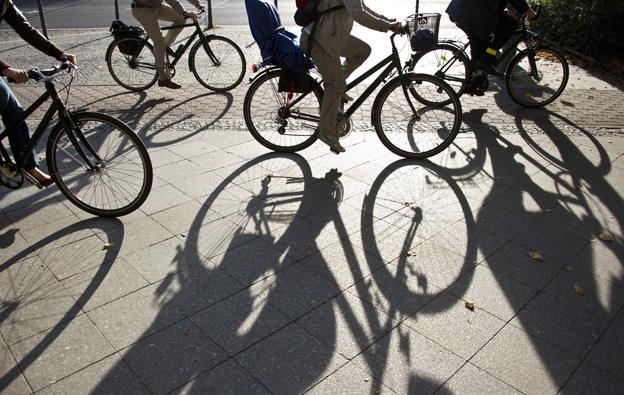
There's been intense debate after a spate of cyclist deaths in the UK in the past two weeks. Here are eight of the most radical solutions suggested to improve safety.
Bicycle licences and even number plates
The idea that cyclists should sign up to a national register - and display something equivalent to a number plate - has been suggested on several occasions. Former London Mayor Ken Livingstone suggested it in 2006, external, and more recently UKIP floated the idea and mentioned third-party insurance for cyclists, external in its 2010 manifesto.
Driver Paul shows what it is like driving a lorry in London
Such a scheme would make it possible to track and identify cyclists on camera, supposedly encouraging them to ride more safely for fear of being caught out.
The idea is wildly unpopular with cycling groups, however, and would be ineffective in reducing fatalities, according to Mike Cavenett of the London Cycling Campaign. "The evidence is that only 2-3% of cyclist collisions are caused by those who break the law, so I can't see what the purpose is," he says.
Critics believe the scheme would almost certainly deter many people from cycling altogether, and nudge some cyclists back into their cars, or on to public transport.
Ban vehicles from city centres
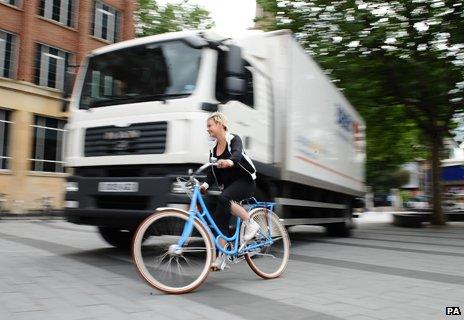
Many cycling advocates say banning lorries from town centres during rush hour - as Paris has - would massively improve safety.
But some would go further and restrict all motor vehicles. Liberal Democrat Norman Baker - formerly transport minister - recently bemoaned the predominance of cars, external in British city centres and called for motor vehicles to be banned from the High Street.
Brian Macdowall, of the Alliance for British Drivers, says that Baker's proposal is a knee-jerk reaction. "Banning vehicles from the city centre just doesn't work," he says. "It just makes that traffic go somewhere else and it can affect trade. We've got to accept the car's been invented."
But dramatic improvements could still be made, says Paul James, author of the Pedestrianise London blog. By eliminating direct routes through particular segments of a city and making walking or cycling much easier, driving can be strongly discouraged if not banned. In the Netherlands this type of road design is already in use, James says. He suggests Soho in London as a potential "segment", and thinks that by barring motor vehicles from driving directly through it, the area could be freed up for other road users.
Heavy goods vehicles making daytime deliveries - which are involved in a large proportion of cyclist fatalities - should unload at depots outside city centres, he says, as they do in a number of Dutch towns. From there private companies are paid to deliver the cargo to local businesses using smaller electric vehicles.
Allow cyclists to jump red lights

In May 2012, Paris began a trial in which cyclists, external would be allowed to carry straight on, or turn right at a small number of traffic lights in the city - even if they were red. The scheme extended what was already common practice in much of the Netherlands and Belgium, where cyclists can turn right (it would be left in the UK) at a red light as standard.
The Parisian authorities say the trial has been a success and that discussions about extending the scheme to the rest of the city are now under way.
Cyclists who jump red lights illegally in the UK already cause both drivers and pedestrians to seethe with anger, but could relaxing the law in certain cases make the roads any safer?
"As long as pedestrian safety was considered... we would give it a cautious welcome," says Cavenett, who stresses that sufficient evidence needs to be gathered before a similar trial is undertaken in London.
Cycle on pavements
Cycling on pavements in the UK is an offence currently punishable with an on-the-spot fine. In Japan, by contrast, most pavements alongside main roads are shared between pedestrians and cyclists.
It is common to see much older cyclists, winding their way along one side of the paths, as well as parents who may be carrying two children at a time - one each on the front and back of their bikes. The pace is very much slower, of course: "I'd hazard a guess at about 8mph," says Danny Williams, a member of London Mayor Boris Johnson's road taskforce, who saw the Japanese system at work on a recent trip to Tokyo. "The way they cycle is very different."
He suggests that the solution could work on large paths running between villages and towns in the UK, but envisages problems in trying to replicate the system in a city like London.
"The thing with Tokyo is, it has very wide pavements," says Williams, who thinks you need about 2.5m to accommodate both cyclists and pedestrians - a luxury that few British pavements can offer.
Ban headphones
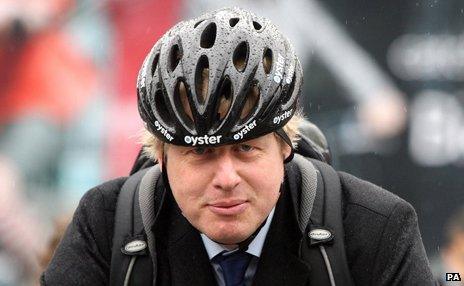
In the wake of the spate of deaths in London, Johnson called for a ban on cyclists wearing headphones as they ride, calling them an "absolute scourge", external on the roads. "Call me illiberal, but it makes me absolutely terrified to see them bowling along unable to hear the traffic," he told BBC London 94.9.
His point is that cycling with any of one's senses wilfully impaired seems inherently more dangerous, so putting an end to the practice would appear to improve the safety of the cyclists concerned.
"I'm inclined to agree with him because that closes up your ears, and you need your ears to work to listen out for traffic," says Macdowall.
Cavenett isn't so sure. "I'd like to know what kind of evidence base the mayor is using. I'm not aware of a single fatality where headphones were implicated."
Body armour
As the debate over the benefit of bike helmets, external continues, a team of Canadian doctors has gone one step further, and suggested that some cyclists should consider wearing protective body armour.
The proposal came following a study of injury patterns among 258 cyclists who sustained serious injuries over a 14-year period. "Almost half of the injuries we noted were either to the chest or abdomen, suggesting that greater physical protection in those areas could also help reduce or prevent serious injury," said Dr Chad Ball, one of the authors of the research paper, external, which argues that "thoracic protection" should be advocated in addition to helmets.
Very little research into the effectiveness of chest pads, for example, has been carried out, but it could give some cyclists pause for thought. After all, motorcyclists frequently don protective armour in addition to their helmets.
Cavenett thinks the suggestion is absurd, however, arguing that additional padding would not have reduced the danger for those seriously injured in road accidents. "Cycling at 10-12mph is not dangerous. The danger is inherent in the lorries and the cars driven at speed. If a 32-tonne lorry runs over your chest it would make no difference."
Elevated cycling routes
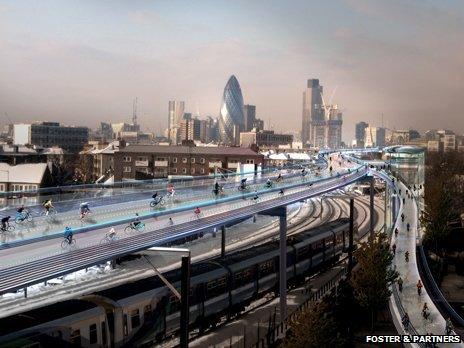
Effective segregation of road traffic is central to most campaigners' demands for greater safety, and SkyCycle is one of the most extreme methods, external of separating bicycles from cars on the agenda. By building a new network of cycle paths high above existing roads and railways, the scheme would create a series of cycle superhighways across London, with specific entry and exit points throughout the city.
"Any long distance bicycle commute would be less likely to encounter large heavy goods vehicles if we are able to build a few of these elevated cycleways," says Sam Martin, founder of Exterior Architecture, the firm behind the designs.
Brian Macdowall, of the Alliance for British Drivers, thinks the project could work in principle. The problem with inserting cycle lanes at the roadside usually means narrowing the road itself, which can aggravate congestion. "If the cycle lanes could run along major routes without loss of road space to motorists, then it would help." He is concerned that the cost would prevent the plans becoming a reality, however. Martin estimates the initial cost at £200m for the first 6.5km artery.
Scrap traffic lights and road signs altogether
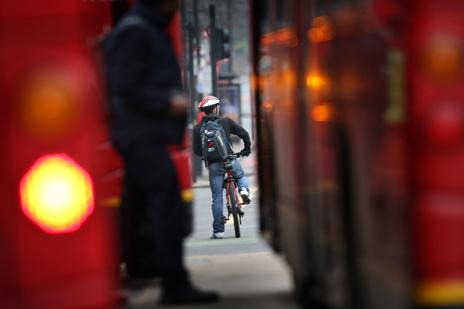
Advocates of the notion of "shared space" suggest that traffic lights, road markings, railings and pavements all conspire to dull motorists' sense of responsibility. By replacing them all with a simple flat open space, drivers, pedestrians and cyclists would all be more aware of one another, and use the space with more respect.
The scheme was pioneered by the late Hans Monderman in the Netherlands, and Ben Hamilton-Baillie from the UK, and has proved highly controversial.
Cavenett dismisses the idea as a red herring. "Those kind of shared space solutions really only work successfully where you have low speeds and low volumes of motor traffic." They cannot be widely implemented in major cities, he says.
Hamilton-Baillie vehemently disagrees, however. "It's a very frequent myth that shared space can only work in low traffic volumes," he says, referring to a recent project in the town of Poynton, external in Cheshire as an example.
By coaxing traffic to move more slowly, cars, bicycles, pedestrians and heavy goods vehicles now safely pass through the busiest shared space junction in the developed world.
How would you improve safety? Tell us your radical solution by commenting on the form below, on Facebook, external or tweeting, external with #makecyclingsafer.